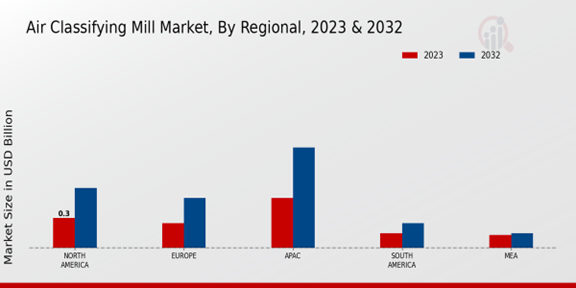Market Growth Projections
The Global Air Classifying Mill Market Industry is poised for substantial growth, with projections indicating a market value of 1.53 USD Billion in 2024 and an anticipated increase to 3.34 USD Billion by 2035. This growth trajectory suggests a robust demand for air classifying mills, driven by various factors such as technological advancements and the expansion of end-user industries. The expected CAGR of 7.35% from 2025 to 2035 further emphasizes the industry's potential for sustained growth. These figures illustrate the dynamic nature of the market and the increasing reliance on air classifying mills across diverse applications.
Technological Advancements
Technological innovations play a pivotal role in the Global Air Classifying Mill Market Industry, enhancing efficiency and performance. Recent advancements in air classification technology enable mills to achieve higher precision in particle size separation, which is crucial for industries like food and pharmaceuticals. For example, the integration of automation and control systems allows for real-time monitoring and adjustments, leading to improved operational efficiency. This ongoing evolution in technology is likely to attract investments, further propelling market growth. The anticipated CAGR of 7.35% from 2025 to 2035 underscores the potential for technological advancements to shape the future of this industry.
Expansion of End-User Industries
The expansion of end-user industries significantly influences the Global Air Classifying Mill Market Industry. Sectors such as food and beverage, pharmaceuticals, and chemicals are experiencing robust growth, necessitating advanced milling solutions. For instance, the food industry increasingly demands finely milled ingredients for product consistency and quality. As these industries expand globally, the demand for air classifying mills is expected to rise correspondingly. This trend is reflected in the market's projected growth, with an expected value of 3.34 USD Billion by 2035, indicating a strong correlation between industry expansion and the need for advanced milling technologies.
Rising Demand for Fine Particles
The Global Air Classifying Mill Market Industry experiences a surge in demand for fine particles across various sectors, including pharmaceuticals, food processing, and chemicals. As industries increasingly require precise particle size distribution for enhanced product quality, air classifying mills become essential. For instance, in the pharmaceutical sector, the need for fine powders for drug formulation drives the adoption of these mills. This trend is projected to contribute to the market's growth, with the industry expected to reach 1.53 USD Billion in 2024, reflecting a growing recognition of the importance of particle size in product efficacy.
Focus on Sustainable Manufacturing
Sustainability initiatives are becoming increasingly prominent within the Global Air Classifying Mill Market Industry. Manufacturers are prioritizing eco-friendly practices, including energy-efficient milling processes and waste reduction strategies. This shift towards sustainable manufacturing not only aligns with global environmental goals but also enhances operational efficiency. For example, air classifying mills that utilize less energy and produce minimal waste are gaining traction among environmentally conscious companies. As sustainability becomes a key driver of innovation, the market is likely to witness a rise in demand for mills that meet these criteria, further supporting industry growth.
Regulatory Compliance and Quality Standards
The Global Air Classifying Mill Market Industry is significantly influenced by stringent regulatory compliance and quality standards across various sectors. Industries such as pharmaceuticals and food processing are subject to rigorous regulations that mandate precise particle size and quality control. Air classifying mills play a crucial role in meeting these standards by ensuring consistent product quality and compliance with safety regulations. As companies strive to adhere to these requirements, the demand for advanced milling technologies is expected to increase. This trend highlights the importance of regulatory compliance in driving market growth and shaping the future landscape of the air classifying mill industry.


















